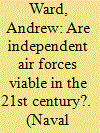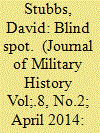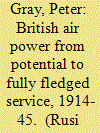| Srl | Item |
| 1 |
ID:
133874


|
|
|
|
|
| Publication |
2014.
|
| Summary/Abstract |
Which modern operations becoming increasingly joint in their nature and airpower now in intrinsic part of every military operation, the need for independent air forces is questioned with special emphasis on the British case
|
|
|
|
|
|
|
|
|
|
|
|
|
|
|
|
| 2 |
ID:
130594


|
|
|
|
|
| Publication |
2014.
|
| Summary/Abstract |
This paper examines why the RAF maintained its view that it would be neither appropriate nor prudent to protect its bombers with long-range fighter escort until the time, late in the day, when the U.S. Army Air Forces' trials to increase the Spitfire fighter's range proved otherwise. The paper argues that some senior RAF officers, who believed that long-range fighters were unnecessary, lacked the conceptual dexterity needed after the RAF's bombers' vulnerability to single-engined fighters became apparent, and that these failings were hidden by a culture of obedience to perceived wisdom that existed within the RAF.
|
|
|
|
|
|
|
|
|
|
|
|
|
|
|
|
| 3 |
ID:
133799


|
|
|
|
|
| Publication |
2014.
|
| Summary/Abstract |
The First World War set British air power on a path of development that by 1939 made an essential contribution to the conduct of war
At the start of the First World War, the potential of air power for military purposes had already been identified but remained largely underdeveloped, with Britain lagging behind some of its direct European competitors. Peter Gray traces how the First World War acted as a catalyst for British forces to use air power in attack and reconnaissance roles, and unleashed the potential for its further development during the interwar years. By the Second World War, air power had become an indispensable element of warfare.
|
|
|
|
|
|
|
|
|
|
|
|
|
|
|
|